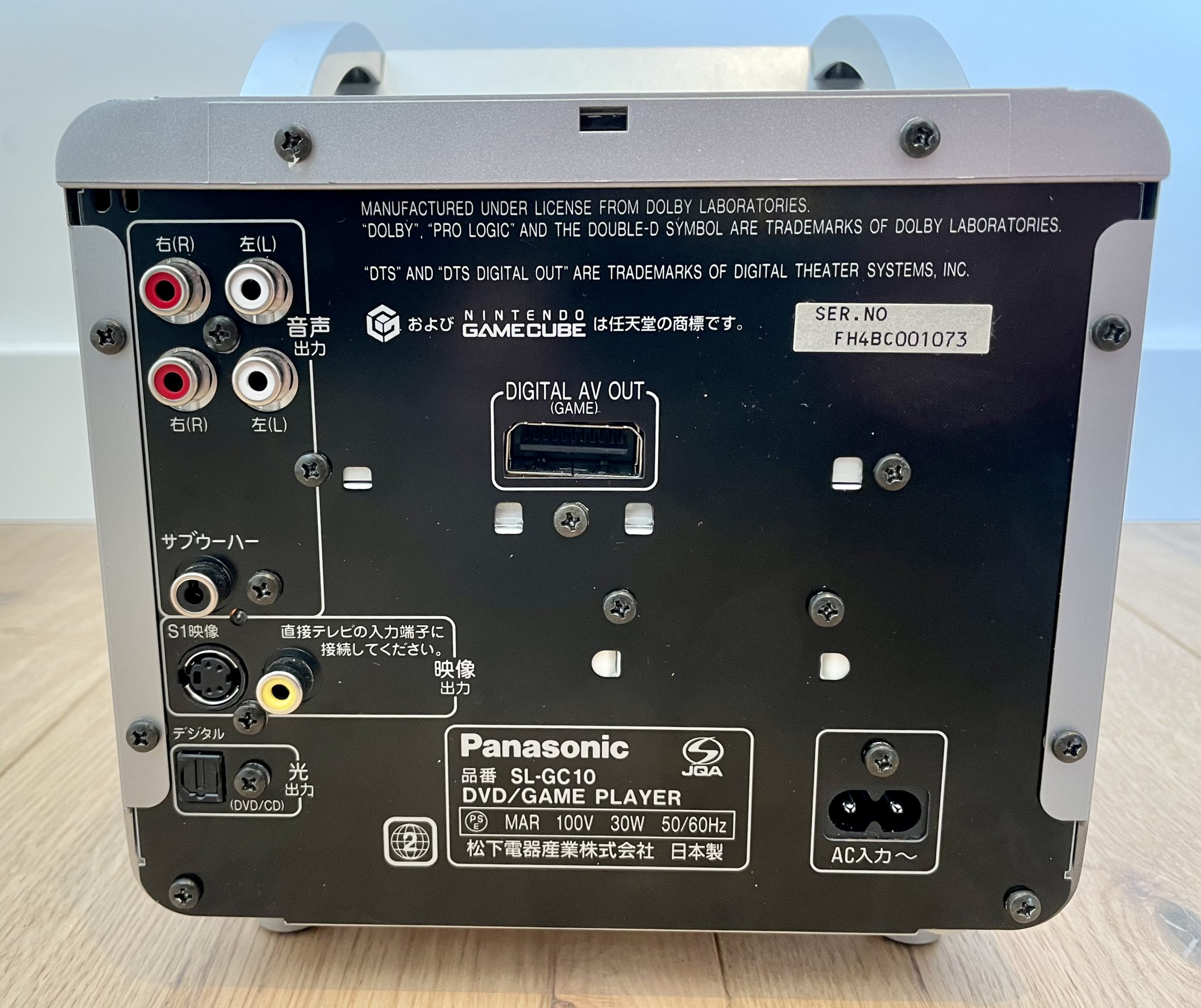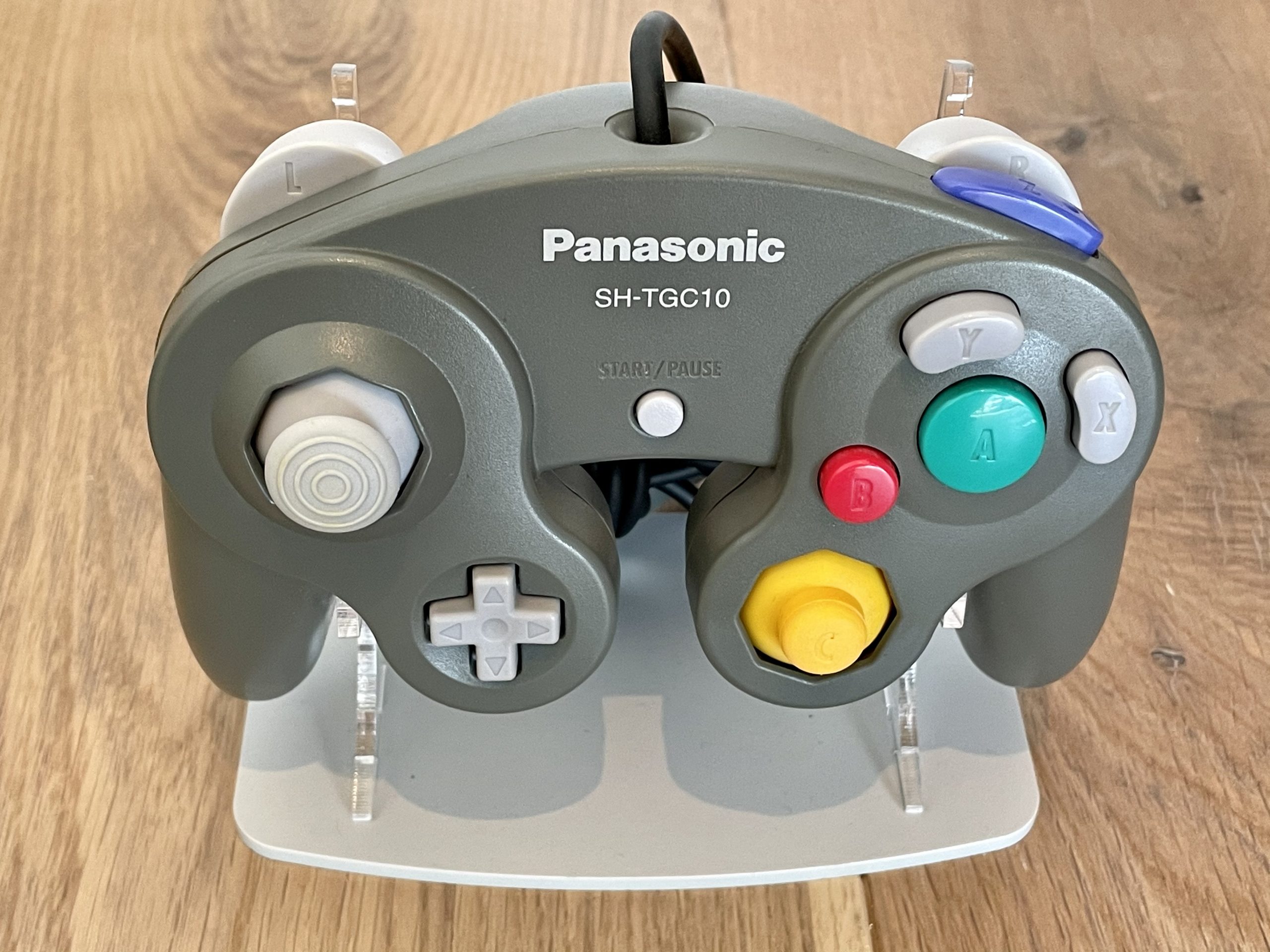

Background
Until the end of the 20th century, Panasonic was the largest electronics concern in the world and during its heyday had almost 400,000 employees worldwide. Despite these successes, the brand has made few steps in the world of gaming. The Panasonic FS-A1 (MSX) and Panansonics variant of the 3DO were a cautious attempt by the company to eat some of the lucrative gaming pie. However, in both cases they did not create their own consoles from the bottom up. They used standardized hardware specifications, of which Panasonic produced its own variant, although with a twist. The introduction of the Panasonic Q in 2001 was no exception to that methodology. The company just did not have enough gaming DNA. However, this didn’t mean that what they produced was bad or lazy.
‘The Q’
The Q belongs to the 6th generation of gaming consoles. This generation was dominated by the Sony Playstation 2 and the Microsoft XBOX. It was a time when gaming became more mainstream. The PS2 would even become the world’s best-selling console and raised the bar with a whole new generation of games. Nintendo, a dominant player in the market, had its first real failure with the Gamecube. Although much loved today, the gamecube, with 22 million copies, contrasts sharply with the 155 million that the PS2 sold. The reasons for this difference were diverse. The PS2 appeared 1.5 years prior to the GC in Japan. Graphically the console from Nintendo could not compete and it had to some extend a childish appearance that was often compared to a bread box. A very important other reason why many gamers chose the PS2, and also XBOX (24 million), was the fact that both consoles had a built-in DVD player. Because of this they rose above the status of dedicated gaming console and became more multifunctional home entertainment devices. The regular Gamecube did have a DVD-player. Nintendo reasoned that using its own disc format, similar to mini-DVD, would prevent piracy of its games. These mini-DVDs had the disadvantage that only 1.5 GB of data could be stored, which limited the possibilities for GC developers. The fact that no DVDs could be played on the GC drove the mainstream gamer into the hands of Microfsoft and especially Sony. In this game of forces, Panasonic entered the market in 2001 with the Panasonic Q.
The ultimate Gamecube
A strange detail is that Nintendo developed the 1,5 GB disk for the GC together with Panasonic. Although not entirely sure, it is probable that is was part of the development deal that Panasonic was allowed to create there own version of the GC with a full fledged DVD-player. So three months after the introduction of the GC, Panasonic introduced the Panasonic Q, affectionately called ’the Q’, on December 13, 2001. The Q is often described as a gaming console. The reason for this is that a full Gamecube has been incorporated into the Q. It was not the first time that Nintendo had closed deals to modify its products. Sharp had already made its own version of the Famicom in the past. Panasonic decided to give the Q its own twist. They developed the Q as a hybrid system, which combines the aforementioned Nintendo hardware with a high-quality DVD player from Panasonic. In that sense, the principle of the Panasonic Q can be compared to the Sony PSX, which was primarily a full-fledged video recorder to which PS2 hardware was added.

Appearance
The Q was given a very special and modern appearance for that time. It is made of aluminum on the back, top and sides.The front is mainly made of glass, which houses the controller ports and a wide variarity of buttons, which control the many functions of the Q. The controller ports also have a bright backlight. The DVD tray is located above the controller ports. At the top of the Q, an elongated monochromatic LCD screen protrudes from the console. It shows the input of the DVD player and the gaming functionalities. The console is a lot bigger than the regular Gamecube. This is due to the incorporation of the DVD-functionlity. Unlike the gamecube, where you have to open a lid on the top to place a game, the Q has a full-fledged DVD tray that runs from the front to the back of the console.
Peripherals
The Q comes with two peripherals. A remote control and a Gamecube controller. The remote control has been specially developed for the Q. With its gray colour it fits well with the look of the console. The button layout also ensures that both the DVD and Game functionalities of the Q are easily accessible. The included controller stands out less. It is a standard Gamecube controller with the Panasonic brand name printed on the front. It is finished in the same matching gray colour.
Since the Q is a lot longer and wider than the regular Gamecube, Panasonic had to develop its own variant of the Gamecube player. Again, in the same gray color scheme. The player was made in a very limited edition and very rare today.
Reception
The Panansoic Q, just like the 3DO, was not a success for Panasonic. This was partly due to the fact that the console was only released in Japan and was a lot more expensive than its competitors. The console was also region locked. it had to be modified to play PAL games, which added to the costs of importing to other parts of the world. In addition, the PS2, with its build in DVD-functionality appeared earlier than both the GC and the Q. It had already conquered a large part of the market, saturating the gaming landscape. Another disadvantage of the Q was that it wasn’t introduces along side the regular Gamecube. In fact it appeared 3 months later. By than many early adopters and Nintodo enthousiasts had all-ready the GC. So the Q came a little to late. As a result, Panansonic stopped production two years after its release. By then the Q only sold 100,000 times. After the previous faillure of the 3DO, the low sales of the Q contributed to the fact that Panasonic lost their interest in the gaming console market.
It is not easy to get your hands Q these days. This is not only due to the limited number of consoles produced. Although aesthetically successful, the Q is far from robust. By far the most fragile part is the DVD trail. It is made of very cheap plastic and breaks easily when resisted. Since the Q was only released in Japan, many collectors are turning to the Japanese retro gaming market. The consoles that are then sent by air or sea transport often do not survive the excess. And because spare parts are no longer made for the Q, the unfortunate owner of a Q with such a defect will have to rely on 3D printed parts. And wheb you aquired the necessary repair parts, Actually repairing the Q is nothing more than terrible. The Q is hold tegether by an insane amount of screws. The stability is however totaly dependent on the backplate. It acts like a shelve, where all the ports slide in and is hold togeter by 16 screws to the frame of the console. When you remove it, as well as the sides the inner parts become visible. The console is divided into two main different layers. In the bottom you find the GC part, above that is the DVD-player located. A vertical mainbord on the right side links both parts and a second motherboard on the top is dedicated to control the monochrome screen. Thats just the top of the ice berg. It is nothing more than a nightmare to disconnect and reconnect al the interwining screws, plugs, cables different boards and other connections. Not for the amateur and certainly not for the faintharted. Far from a intuitive system and it proves the difficulty Panasonic had to convert the GC en DVD-part in one intertwined system.
As a result, a Q in working condition is a rarity outside of the home country. This drives up prices. Ebay is full of ‘junk’ Q’s. For a boxed Panasonic Q in good condition, you quickly have to pay 600 euros and then hope that it will arrive at you well. Insured shipping is a must.
The Pansonic Q is a rare console, but working systems are regularly offered on ebay.
| SPECS | |
|---|---|
| Name | Panasonic Q (SL-GC10) |
| Nickname | The ‘Q’ |
| Type | Home Console/DVD player |
| Sort | Limited edition |
| Lifespan | 2001-2003 |
| Brand | Panasonic |
| Generation | 6th |
| Worth | 700-850 euro (boxed) 600 euro (stand alone) |
| Prices | 41.000-46.000 yen (320-350 euro) |
| Units | less than 100.000 |
| Rarity | very rare (working order and in good condition) |
| Predecessor | Panasonic 3DO |
| Successor | – |
| Dimensions | 180 x 217 x 198 mm |
| Weight | 3 kg |
| CPU | 32-bit PowerPC 750CXe Gekko @ 486 MHz. |
| GPU | Ati Flipper @ 162 MHz. (1.94 GFLOPS) |
| RAM | 43 MB (System – 24 MB, 3 MB GPU, 16 MB DVD \ Audio buffer) |
| Screen resolution | 720 x 480 (480i, 480p) 720 x 576 (576i) |
| Media | Nintendo optical discs (8cm 1.5 GB), DVD, CD, MP3-CD, Video-CD. |
| Power | AC 100 V 50/60 HZ |
| Region code | NTSC (Japan) |
| Connections | Composite, S-video, Digital AV-out |
| Peripherals | -remote control -dedicated controller -Panasonic Q Gameboy player |














Pingback: The Second Video Game Crash!? - Retrogamer
Pingback: Panasonic 3DO FZ-1 - Retrogamer